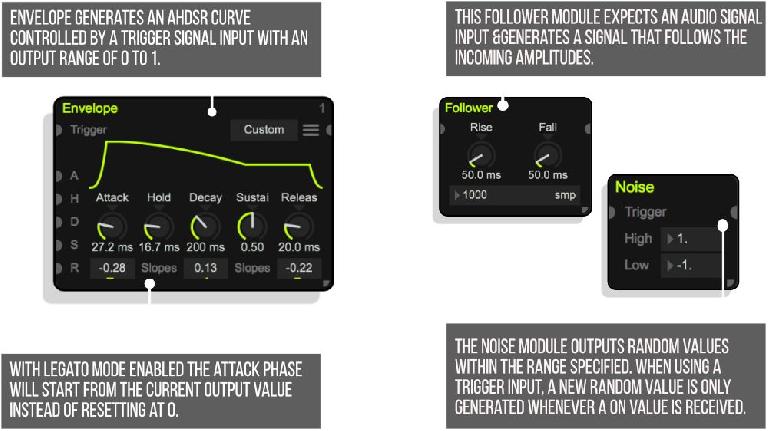Over the past twelve months Chaos Culture have been working tirelessly on Signal, a set of MaxforLive building blocks that allow you to build your own signal flow that can be used to create audio, control voltage or just modulate anything in Live.
MaxforLive can represent a steep learning curve to someone who hasn't learnt how to code before, it's graphical manner certainly helps reduce that somewhat but it can be a labour of love in the first instance to get pleasing results when you first open it.
And yet nothing else is as powerful when connected in live through the API via the Live Object Model. We wanted to create a system that would allow you to quickly drag together pre-built modules without having to worry about learning how to achieve a result but still be advanced enough that the most technical of users could also benefit.
Signal is a toolbox of those modules that can be connected together to create or modify signals from Ableton Live, transform and output them as Audio or control for parameters. Begin by spawning modules from the menu and then connect them with patch cords by clicking on each modules inputs (left) and outputs (right). You can click on any output to monitor its signal within the scope and all modules run at audio rate. Use the Audio In & Out Modules to exchange signals between devices or to send & receive control voltage.
Signal is a node based / modular playground for control signals such as LFOs, envelopes and automations. Some Max for Live control devices have a lot of issues and limit the possibilities by completely taking over the control of a parameter in Live. Signal uses audio signals for all its calculations and lets you route them however you want giving you a lot more options while keeping the highest quality possible along with staying sample accurate.
Additionally it eliminates chain mapping, where you would use an LFO on another one. Since every mapping in Live introduces a delay as well as CPU usage, chain mapping is not useful at all. With Signal you only need one mapping to make everything possible. You can always add another signal and keep expanding the setup. Especially by using multiple instances you can use Lives own routing to mix control signals, record them and play them back in any way using the session view, the Looper device or simply by triggering them using Simpler/Sampler.
The modules in Signal are versatile, you don’t need a lot of them to create something useful. With a lot of additional features that haven’t been done before, bypassing mapped parameters for example, Signal is the ultimate control device.
With the flexibility Signal becomes a meta language, you can basically create your own control devices exactly how you like it without actually having to program them in Max. Signal takes away all the work of getting the basics to work and leaves you only with the decision making.
SIGNAL MODULES
INPUTS & OUTPUTS
- Audio In / Out – Receive and send audio using the device inputs and outputs.
- Dial – This module simply outputs the dial value, which can be automated.
- MIDI In / Out – Receives and sends MIDI data.
- Note In – Receives MIDI notes and outputs a trigger, pitch and velocity signal.
- Observer – This module outputs the value of any parameter in Live.
- Remote – Controls parameters in Live with the incoming signal.
GENERATORS
- Envelope – Generates an AHDSR curve controlled by a trigger signal input with an output range of 0 to 1.
- Follower – This module expects an audio signal input and generates a signal that follows the incoming amplitudes.
- LFO – The curve is customizable and the presets in the list above can be used as a starting point.
- Noise – This module outputs random values within the range specified (including the low and high values themselves).
TRANSFORMERS
- Function – This module translates an incoming signal using a customizable curve.
- Spread – This module will take multiple inputs and adds a value to it speci#ed with the number directly next to the input.
EFFECTS
- Jitter – This module creates a jitter signal with a customizable frequency, which you can then mix together with other signals.
- Smooth – This module takes a signal and smoothes it out to avoid quick movements.
TIMING
- Clock – This module generates a clock signal that loops after a set amount of bars.
- Counter – Whenever this module receives a trigger ON value it will count the Milliseconds, samples or beats (quarter notes / clock signal) that have passed.
- Delay – This module can delay a signal with positive values as well as negative, which will add latency.
- Swing – With this module you can apply swing onto any signal.
BASICS
- Math – You can perform basic math operations by selecting a method in the drop down.
- Movement – This module analyses an incoming signal and reports its movement.
- Range – The incoming signal will be kept within a customizable range.
- Scale – This module allows you to scale a signal by using 4 reference points. If the module receives the value speci#ed in the top left, it will result in the value shown in the top right. The same goes for the bottom two values.
ROUTING
- Mix – This module simply mixes multiple signals together.
- Trigger Merge – This simple module will analyse multiple trigger signals and create a single.
Price: $49.99
Web: https://isotonikstudios.com/product/signal/
Learn more about Ableton Live and Max4Live: https://ask.audio/academy?nleloc=category/audio/application/ableton




 © 2024 Ask.Audio
A NonLinear Educating Company
© 2024 Ask.Audio
A NonLinear Educating Company
Discussion
Want to join the discussion?
Create an account or login to get started!